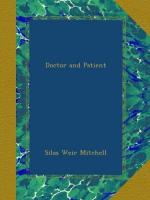I remember well a consultation in a case of great obscurity, into which, many years ago, the late Dr. G. was called, after three of his colleagues had failed to reach a conclusion. It was suspected that poisoning by lead was the cause of a singular and unusual train of symptoms. Now, in such cases, a blue line around the junction of the teeth and gums is a certain sign of the presence of that poisonous metal. The patient, a man of seventy-five years, was known by his own physician to wear full sets of artificial teeth, and he so said. This having been stated no one looked at the gums. At the close of the second meeting Dr. G. turned back unsatisfied. “Let me see your gums. Ah!” he said. There was the stump of one incisor left, and around it the blue line told a tale which ended all doubt.
On another occasion, a young physician well known to me, fell by a chance into a consultation with Dr. P., the physician I have mentioned, and the late Professor P. The case was one of a young man who several times had been found at morning in a stupor. The attacks were rare, and what caused them was unknown. The young physician, much embarrassed, was civilly asked to examine the case, and did so with a thoroughness which rather wearied the two older men. When they retired to an adjoining room, he was asked, as our custom is, to give, as the youngest, the first opinion. He said, “It is a case of epilepsy. He has bitten his cheek in the fit.” Dr. P. rose without a word and went out. Returning in a few moments, he said, “You are right. I did not look far enough back. You will reach, sir, a high rank in our profession.” The case was thenceforward plain enough. These are rare illustrations of my meaning, and may suffice, with one which has a more humorous aspect. Meeting the late Professor C. D. M. on the steps of a house where, the day before, we had seen together a woman critically ill, he said to me, “Mrs. B. is better, doctor, much better.” “And how do you know that?” I returned. “Her windows are open, my dear doctor. She wants more light. She must be better, much better.” And so she was, as it proved.
A final result of the multiplication of the means of research, and the increasing difficulty in becoming expert in the use of the many and delicate instruments they require, is the growth of what we call specialties in medicine. The best of us learn to use the ophthalmoscope to look into the eye, to use the laryngoscope for the larynx, and can at need examine the urine and the blood, but the men must be rare who are as competent to use each and all of these means as persons who devote themselves to single branches of our work. Moreover, the element of time comes in, as well as the element of such constant familiar practice as makes for one man commonplace and easy what for another, who is more generally occupied, is uncommon and unfamiliar. The specialist profits by the fact that his experience becomes enormous and his work advantaged by its definite




